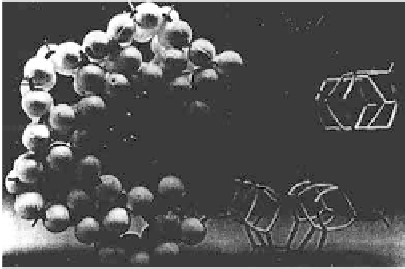Geoscience Reference
In-Depth Information
12-ring of AlPO
4
-11 adsorbs cyclohexane but not neopentane. The pore size is
similar to that of ZSM-5. Two of the 8-ring structures, AlPO
4
-17 and AlPO
4
-18,
sorb butane but not isobutane. AlPO
4
-14 and AlPO
4
-33 sorb xenon, but not butane,
indicating a somewhat puckered 8-ring structures. Similarly, the 16-ring structures
of AlPO
4
-16 and AlPO
4
-20 absorb only water. The pore volumes are near satura-
tion values—O
2
at 183
C and H
2
O at ambient temperature.
In general, the H
2
O pore volumes are usually greater than the O
2
pore volumes,
reflecting the presence of additional pore volume accessible to H
2
O but not to O
2
.
The model of AlPO
4
-5 structure shown in
Figure 6.42
indicates large pore voids
capable of absorbing O
2
or H
2
O; the small voids shown in
Figure 6.43a and b
are
outlined by columns of twisted chains of 4- and 6-rings parallel to the c-axis,
adsorb H
2
O only. In AlPO
4
-5, these small voids apparently sorb about 0.12 cm
3
/g.
Figure 6.44
shows the O
2
isotherms of AlPO
4
-5, -11, and -17, compared with those
of a typical zeolite, Na-X, and a silica molecular sieve, silicalite. The AlPO
4
-5
and -17 have saturation pore volumes of
0.2 cm
3
/g, similar to that of silicalite,
while AlPO
4
-11 has a relatively small O
2
pore volume (
B
0.1 cm
3
/g).
Figure 6.45
shows the H
2
O adsorption isotherms for AlPO
4
-5, -11, -17, and -20.
For comparison, the hydrophilic Na-X and the hydrophobic silicate are considered.
A very unusual shape has been obtained for the AlPO
4
adsorption curve for O
2
and
paraffins.
In recent years, with the discovery of VPI-5 and other large pore zeolites, sev-
eral advantages have been found. AlPO
4
-5 adsorbs O
2
and some hydrocarbons
except for triisopropylbenzene. The triisopropylbenzene is too large to penetrate
the 12 T-atom ring of AlPO
4
-5. VPI-5 reveals two phenomena not observed for
AlPO
4
-5: Firstly, triisopropylbenzene is adsorbed; secondly, the adsorption capacity
monotonically decreases with increasing adsorbate size. Since VPI-5 contains
larger pores of 12
B
13
˚
, all adsorbates other than triisopropylbenzene have the
possibility of fitting more than one molecule across the diameter. In other words,
packing of adsorbate molecules may be important in these extra-large pores.
Table 6.21
gives the adsorption capacity of AlPO
4
-5 and VPI-5 for various adsor-
bates
[131]
. Davis et al.
[131]
have measured the complete argon adsorption
isotherms at liquid argon temperatures. The data obtained from Na-X and VPI-5
Figure 6.42 The model of AlPO
4
-5
structure
[129]
.


